Sour pho is a traditional dish of the Tay people that has been part of Ha Giang’s culinary landscape for over three centuries. Unlike conventional pho from lowland regions, sour pho isn’t served in broth but instead comes with a sweet and tangy sauce made from a special recipe. It’s typically enjoyed with aromatic grilled char siu pork, mildly spicy Chinese sausage, and crunchy pickled papaya, creating a distinctive flavor profile that leaves a lasting impression on anyone who tries it.
In this article, Phieu Travel will guide you through the unique flavors of Ha Giang sour pho, recommend authentic places to enjoy it, and show you how to prepare this specialty at home.
1. Falling in Love with Ha Giang Sour Pho
Sour pho originated from “Luong Pan,” meaning “cold pho” in Chinese, which came from Manchuria (China). This dish traveled with Tay people to northern mountainous provinces like Ha Giang, Lao Cai, and Lang Son over 300 years ago. Over time, cold pho was adapted into Vietnamese culture as sour pho, developing its own distinct appearance and flavor that became an integral part of the rocky plateau’s culinary heritage.
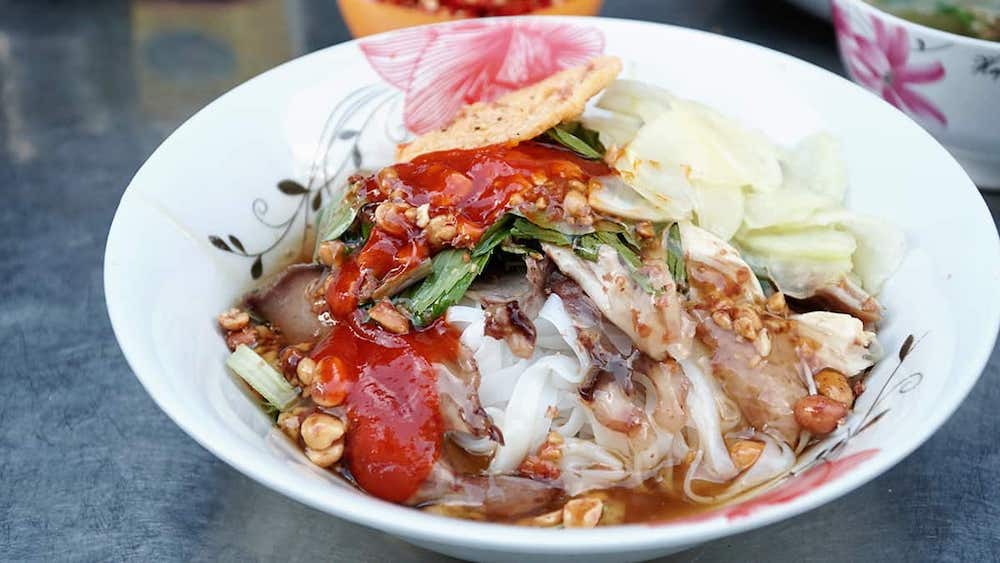
Unlike traditional broth-based pho, sour pho features a sweet and tangy sauce made from rice vinegar, meat cooking water, sugar, and cassava flour for thickening. This mixture is seasoned with pepper and bouillon, then simmered over low heat to maintain a light consistency and clean taste. The sauce doesn’t overpower the ingredients but rather connects the flavors with just enough tanginess, sweetness, a hint of spice, and a subtle salty finish.
A proper serving of Ha Giang sour pho includes soft fresh rice noodles topped with charred-edge grilled char siu, roast duck, Chinese sausage, crushed peanuts, fragrant fried garlic, and fresh herbs like Vietnamese balm, shredded papaya, and cucumber. Everything is artfully arranged and drizzled with sauce. The dish offers a delightful contrast of crunchy vegetables, savory meats, and sweet-sour sauce, creating an unusual yet addictive flavor experience.
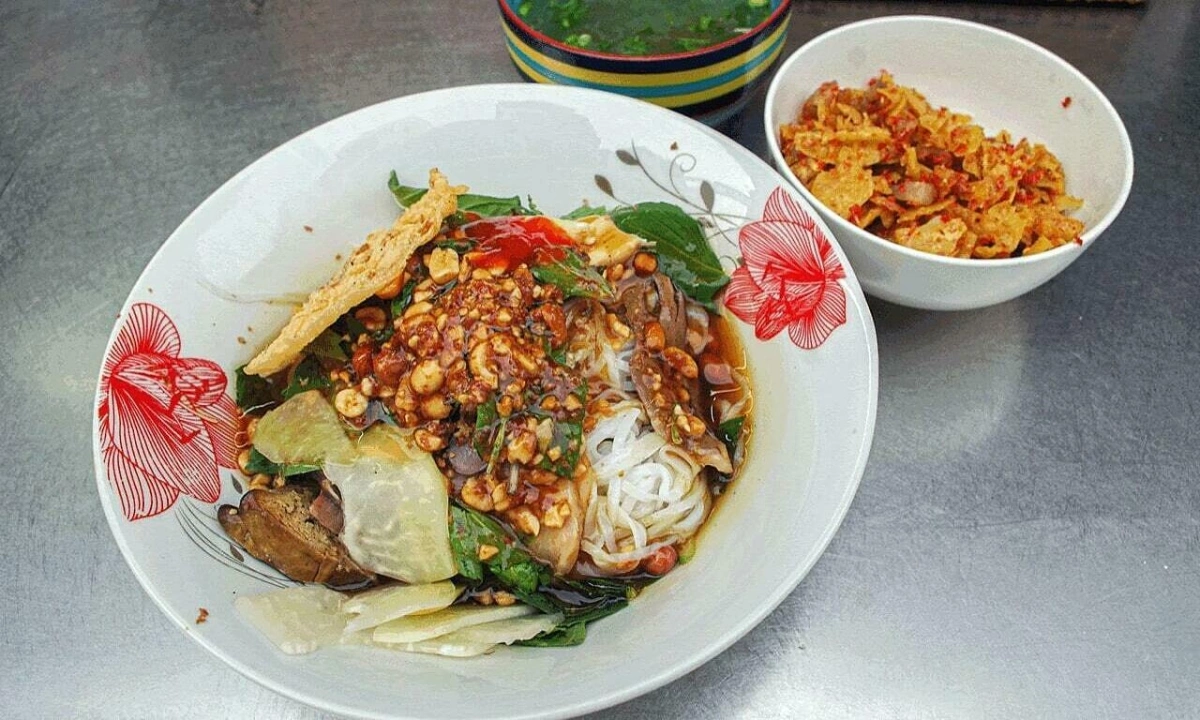
Depending on your preference, you can add simmered chili, chili sauce, or a few drops of fish sauce to enhance the flavor. Locals typically enjoy sour pho for lunch or in the afternoon, sometimes accompanied by corn wine or mulberry wine to keep warm in the highland climate.
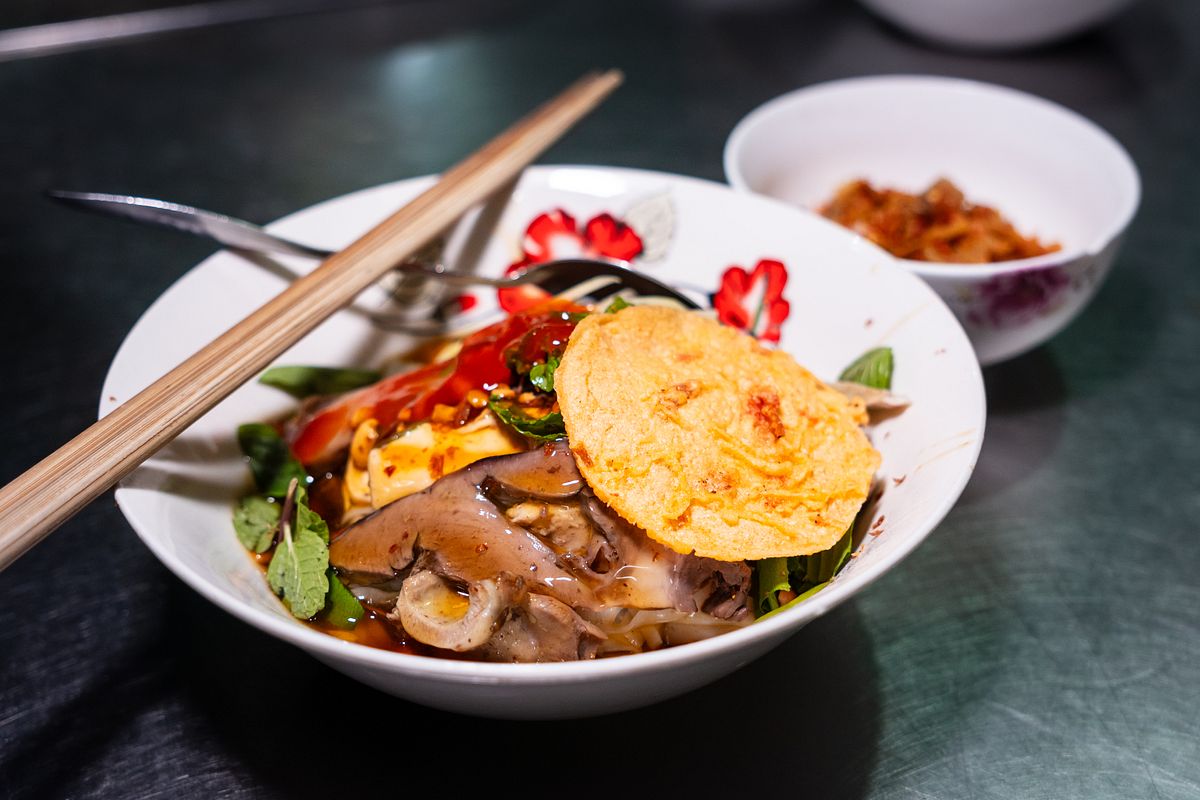
2. 3 Irresistible Places to Eat Ha Giang Sour Pho
While sour pho is readily available throughout Ha Giang, finding the authentic traditional version with perfectly balanced sweet-sour sauce, fresh daily rice noodles, and aromatic grilled char siu can be challenging. If you’re wondering where to find the best sour pho, here are three highly recommended spots by locals and travelers:
Hien Luong Traditional Sour Pho Restaurant
One of the most authentic sour pho restaurants in Ha Giang City center. The space is spacious and clean. The owner and staff are friendly, and despite being busy, service is quick.
- Address: 12 Bach Dang, Ha Giang City
- Opening hours: 07:00 – 21:30
- Price range: 25,000 – 35,000 VND
Ly Dinh Sour Pho
A spacious restaurant with comfortable seating and efficient staff. The pho features soft noodles, generous portions of char siu and roast duck, and abundant fresh herbs. The sauce is flavorful and well-balanced. A bonus is their distinctive homemade chili paste.
- Address: 543 Nguyen Trai, Ha Giang City, Ha Giang
- Opening hours: 07:00 – 21:00
- Price range: 35,000 – 70,000 VND
Sour Pho Stalls at Dong Van Market
Traditional sour pho served at small stalls in the periodic market. Watching the vendor prepare your pho right before your eyes is a distinctive experience. Often enjoyed with Hmong corn wine for a complete flavor experience.
- Address: Dong Van Town, Ha Giang
- Opening hours: Every Sunday
- Price range: 25,000 – 50,000 VND

Ha Giang’s Buckwheat Cake: Heritage, Flavor, and How to Try It
3. How to Make Authentic Sour Pho
The traditional version uses char siu, but here is a simplified homemade recipe using stir-fried beef that you can easily make.
If you haven’t had the chance to visit Ha Giang to taste this renowned sour pho, you can still prepare it at home. The ingredients are relatively easy to find, and the process isn’t complicated if you follow the right steps.
Ingredients
- Beef: 500g
- Beef bones: 500g
- Rice flour: 1kg
- Naturally fermented rice vinegar: 3 tablespoons
- Sugar: 2 tablespoons
- Cassava flour: 1 teaspoon
- Onion: 1
- Ginger: 1 piece
- Green onions: 3 stalks
- Garlic: 2 cloves
- Fish sauce: 1 tablespoon
- Pepper: 1 teaspoon
- Fresh herbs and vegetables: Bean sprouts, coriander, green onions, perilla, basil, sawtooth herb, lettuce, shredded papaya, shredded cucumber…
Preparation Steps
The process of making Ha Giang sour pho at home consists of the following 6 steps:
Step 1 – Prepare the ingredients
Wash the beef thoroughly, slice it thinly, then marinate with fish sauce, pepper, and minced garlic and onion for about 30 minutes to allow the flavors to penetrate. Blanch the beef bones in boiling water to remove impurities and odors, then drain to prepare for the stock.
Fresh herbs like basil, perilla, sawtooth herb, and coriander should be washed in diluted salt water then drained, ensuring they retain their fragrance and crispness when served.
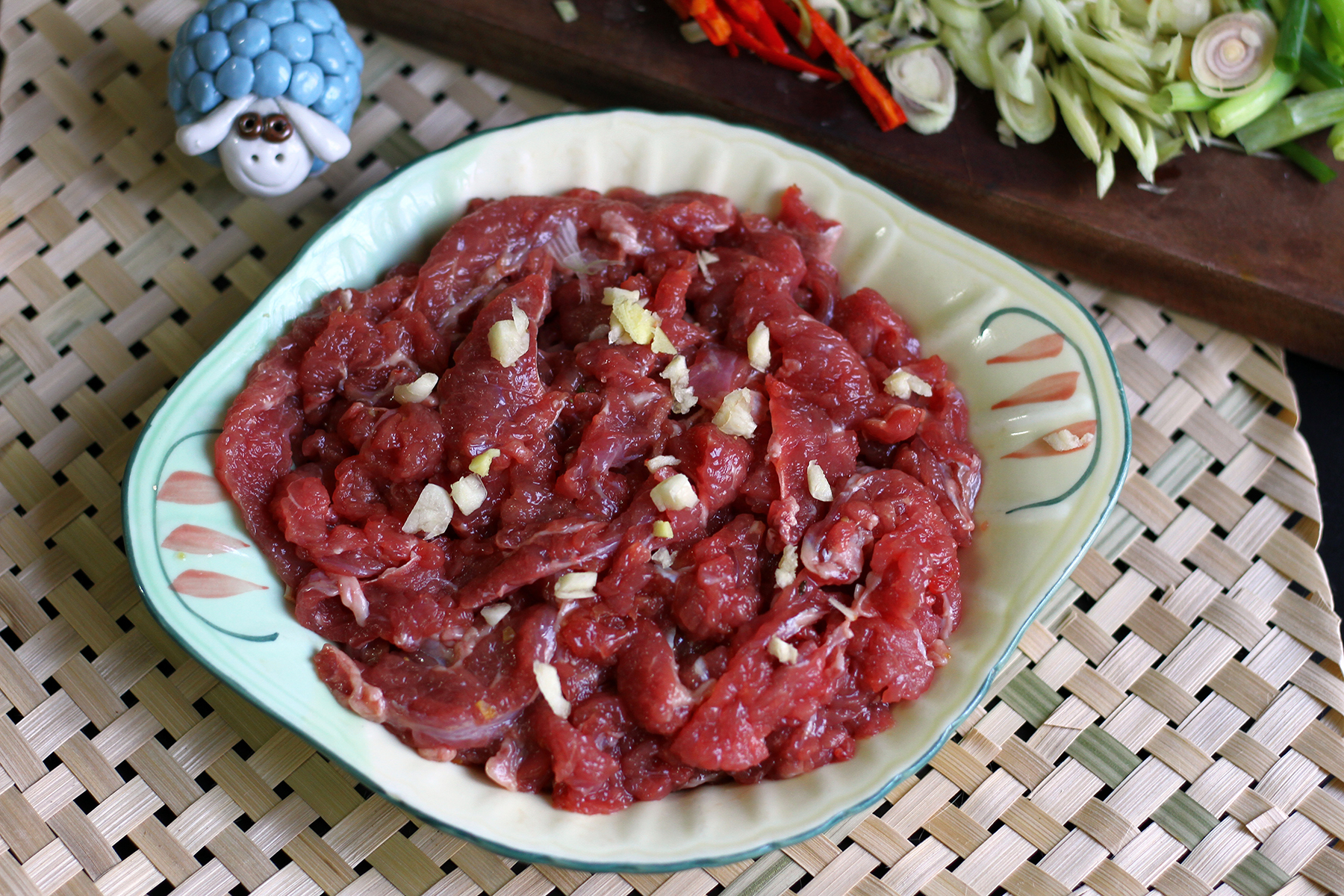
Step 2 – Make the stock
Place the beef bones in a large pot with just enough water and simmer on low heat for about 2 hours. Throughout the simmering process, continuously skim off foam to keep the stock clear and clean-tasting.
When the bones have softened, strain the stock through a sieve to remove bone fragments and small sediments. Bring it back to a boil, then add sliced onion and ginger to enhance the natural aroma. Finally, season lightly with a bit of fish sauce or fine salt to round out the flavor. Don’t over-season as it will affect the overall taste of the dish.
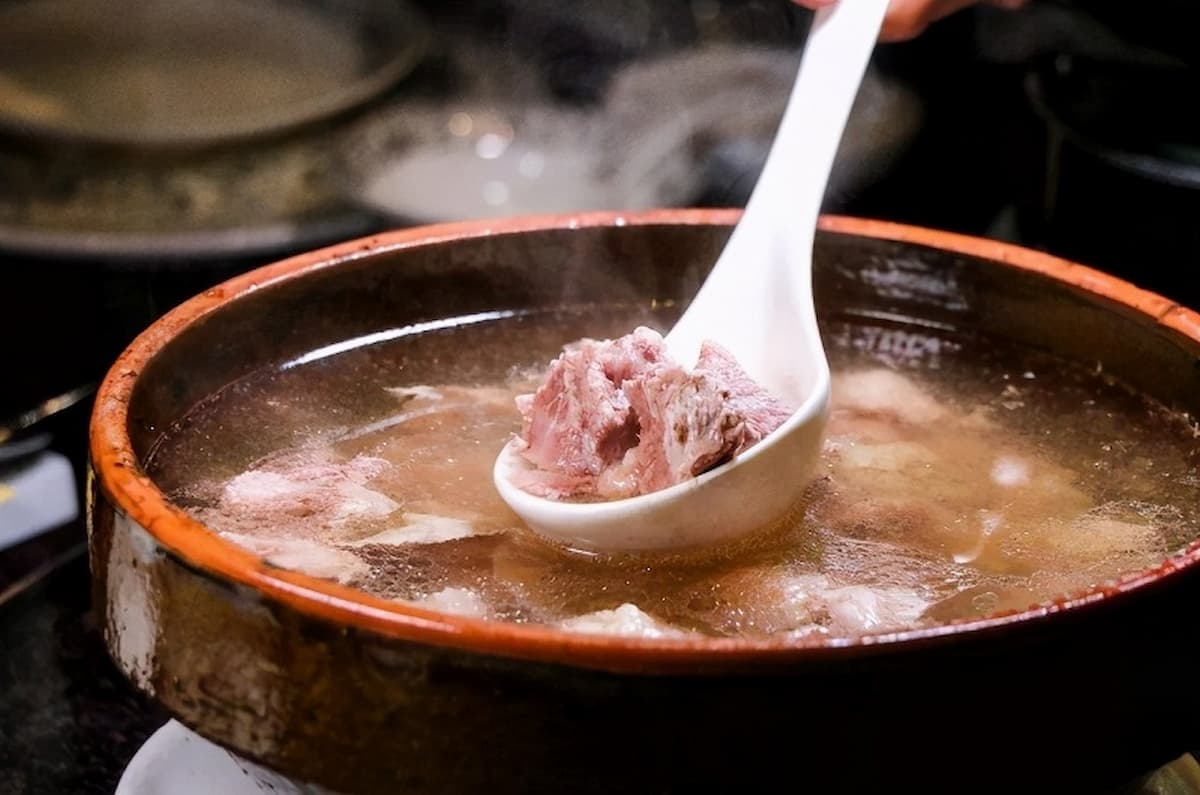
Step 3 – Make the rice noodles
Place rice flour in a large bowl, add water, and knead into a smooth, elastic dough until it no longer sticks to your hands.
Divide the dough into small portions, roll each out thinly and evenly, then cut into noodles of moderate thickness. Bring water to a boil, blanch each batch of noodles until just cooked, then immediately transfer to cold water to maintain their chewy texture, softness, and prevent sticking when mixed with the sauce.

Step 4 – Stir-fry the beef
Stir-fry the marinated beef from step 1 in oil until medium-rare. Avoid overcooking as it will make the meat tough and lose its natural sweetness.
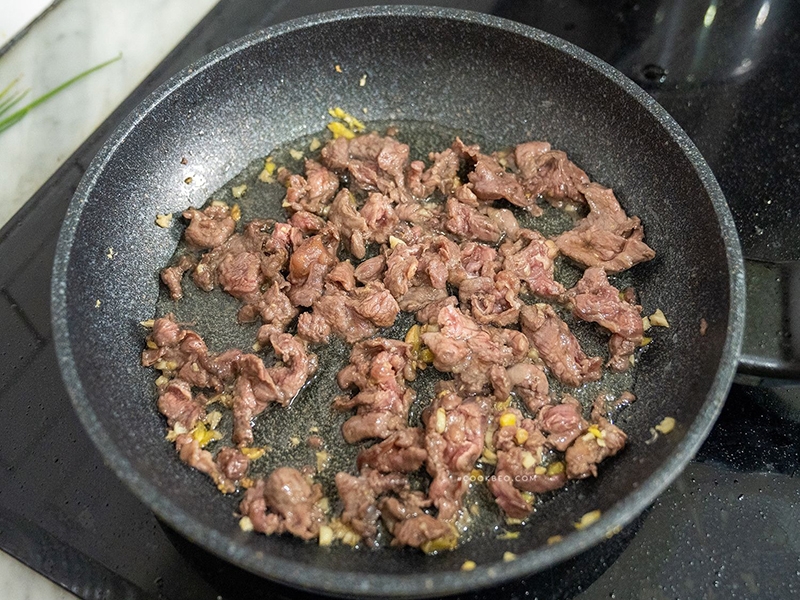
Step 5 – Make the sweet and sour sauce
Prepare a small pot, add 3 tablespoons of rice vinegar, 2 tablespoons of sugar, and 2 tablespoons of the beef bone stock. Simmer over low heat, stirring gently until the sugar dissolves completely. Next, dissolve 1 teaspoon of cassava flour in a little water, then slowly pour it into the pot, stirring continuously to create a naturally translucent consistency.
When the mixture begins to thicken slightly and develops a subtle shine, add a pinch of salt or fish sauce to balance the flavors. Turn off the heat as soon as the sauce reaches the desired consistency, avoiding cooking it too long which could make it cloudy or overly pungent.
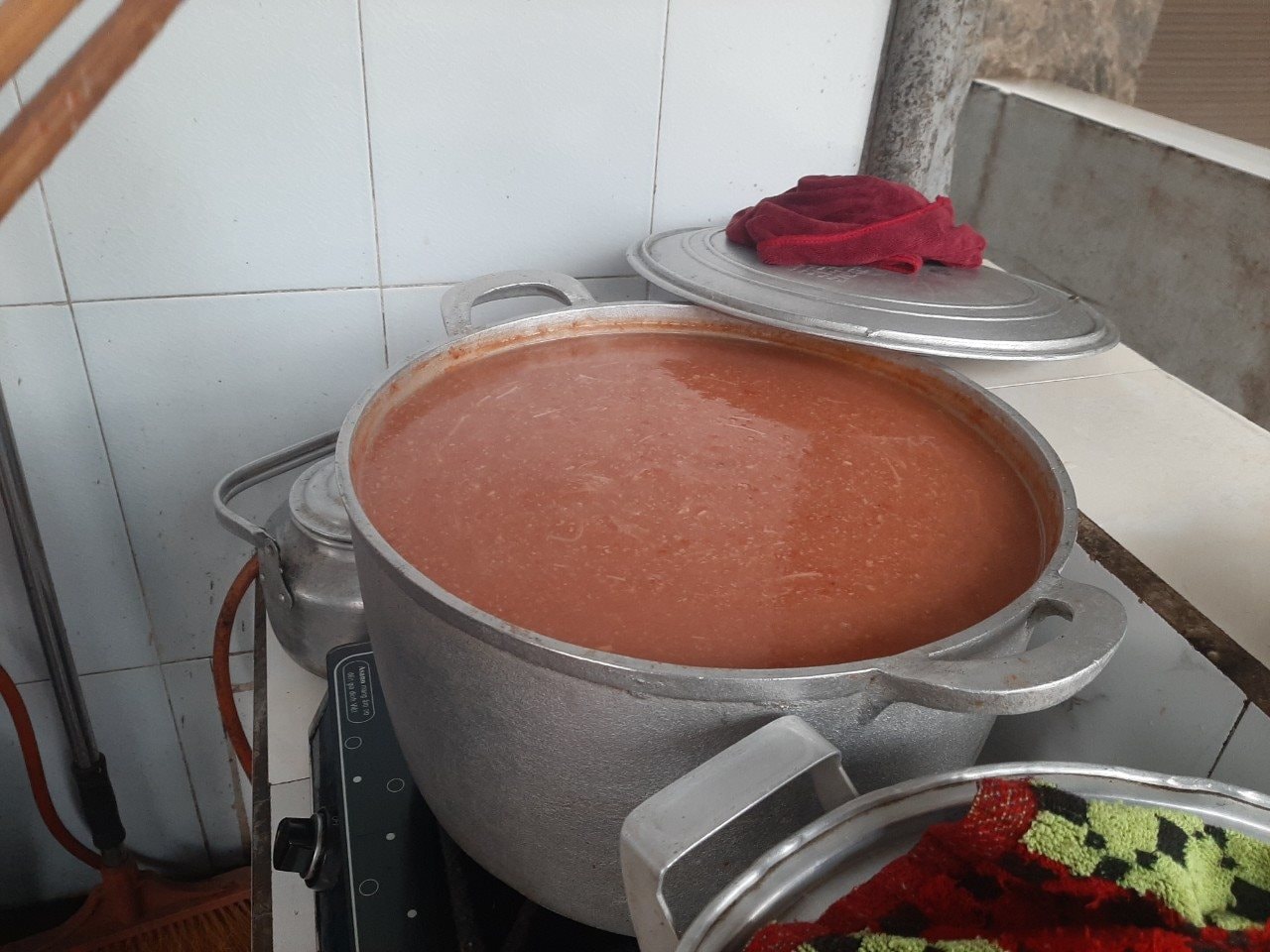
Step 6 – Present the dish
Arrange the fresh rice noodles in a bowl, spread the hot stir-fried beef on top. Pour the warm sweet and sour sauce over to allow the noodles to absorb the flavors, creating a gentle aroma. Next, sprinkle fresh herbs, shredded papaya, and cucumber on top to balance the taste and add freshness. If you like it spicy, add a spoonful of simmered chili to complete the flavor. The remaining stock from simmering the bones can be served as a side soup.
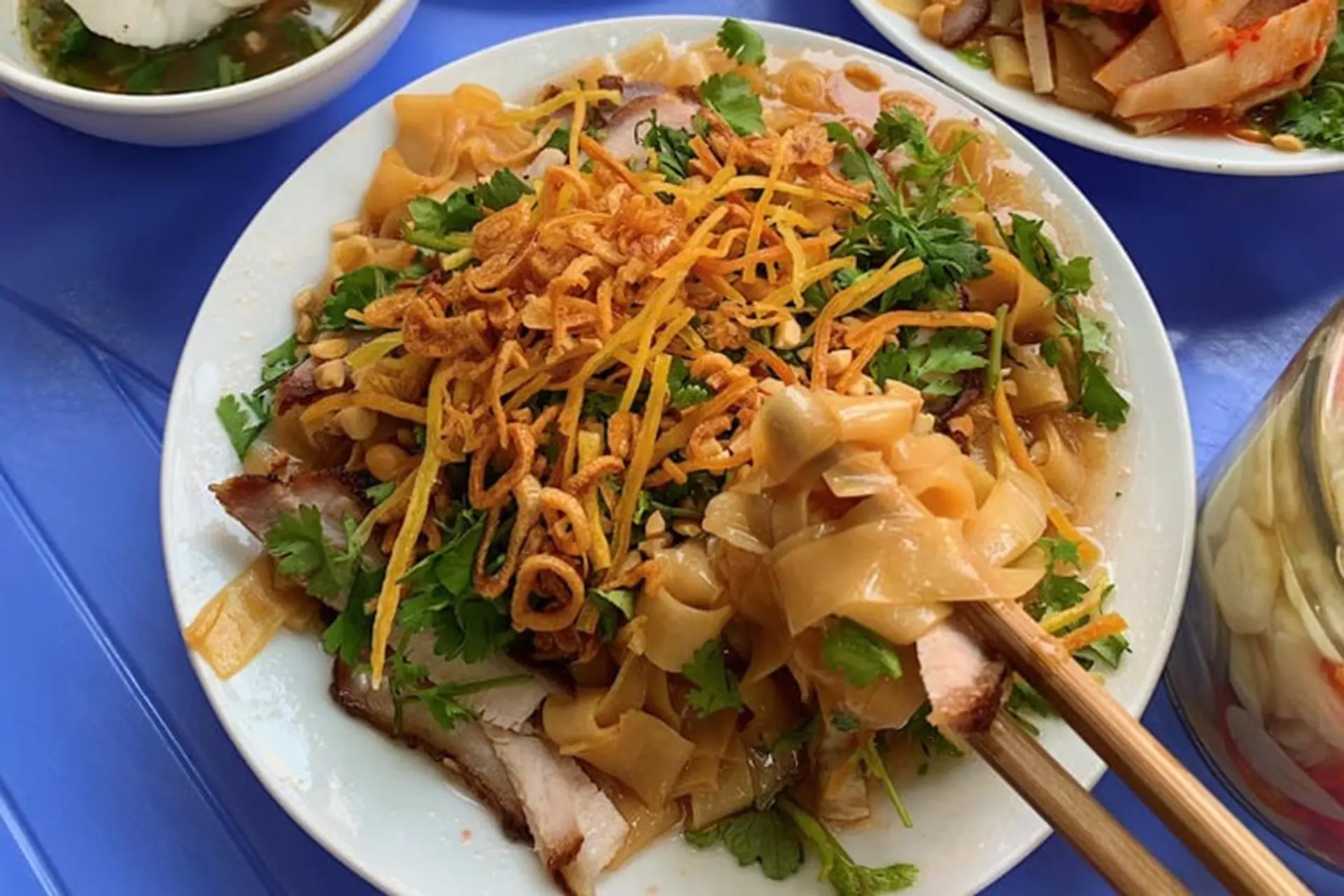
Ma Pi Leng Pass – The Majestic Beauty of Ha Giang’s Stone Plateau
4. The Legacy of a 300-Year-Old Specialty
Sour pho has been present in the lives of Tay people in Ha Giang for over three centuries. Though humble, this dish always appears during festivals, Tet holidays, and death anniversaries, as an essential part of local culture. After days of hard work in the fields, a bowl of sour pho helps replenish energy while providing an opportunity for families to gather, sharing stories about harvests and daily life.
With tourism development, sour pho is no longer limited to Tay kitchens or highland markets. This dish is now widely introduced as a Ha Giang specialty. The clean tanginess of the vinegar, the tender aroma of char siu, and the fresh crispness of the vegetables create a unique combination unlike any other type of pho. Sour pho might intrigue visitors at first taste, then leave them with lasting memories.
For Phieu Travel, Ha Giang’s beauty lies not only in its majestic landscapes or highland identity but also in its flavors. During every meal along the journey, we always incorporate local specialties – and sour pho is an essential part. Stopping at a famous pho restaurant or a Tay stall in the periodic market to enjoy an authentic dish of sour pho is an unforgettable experience.
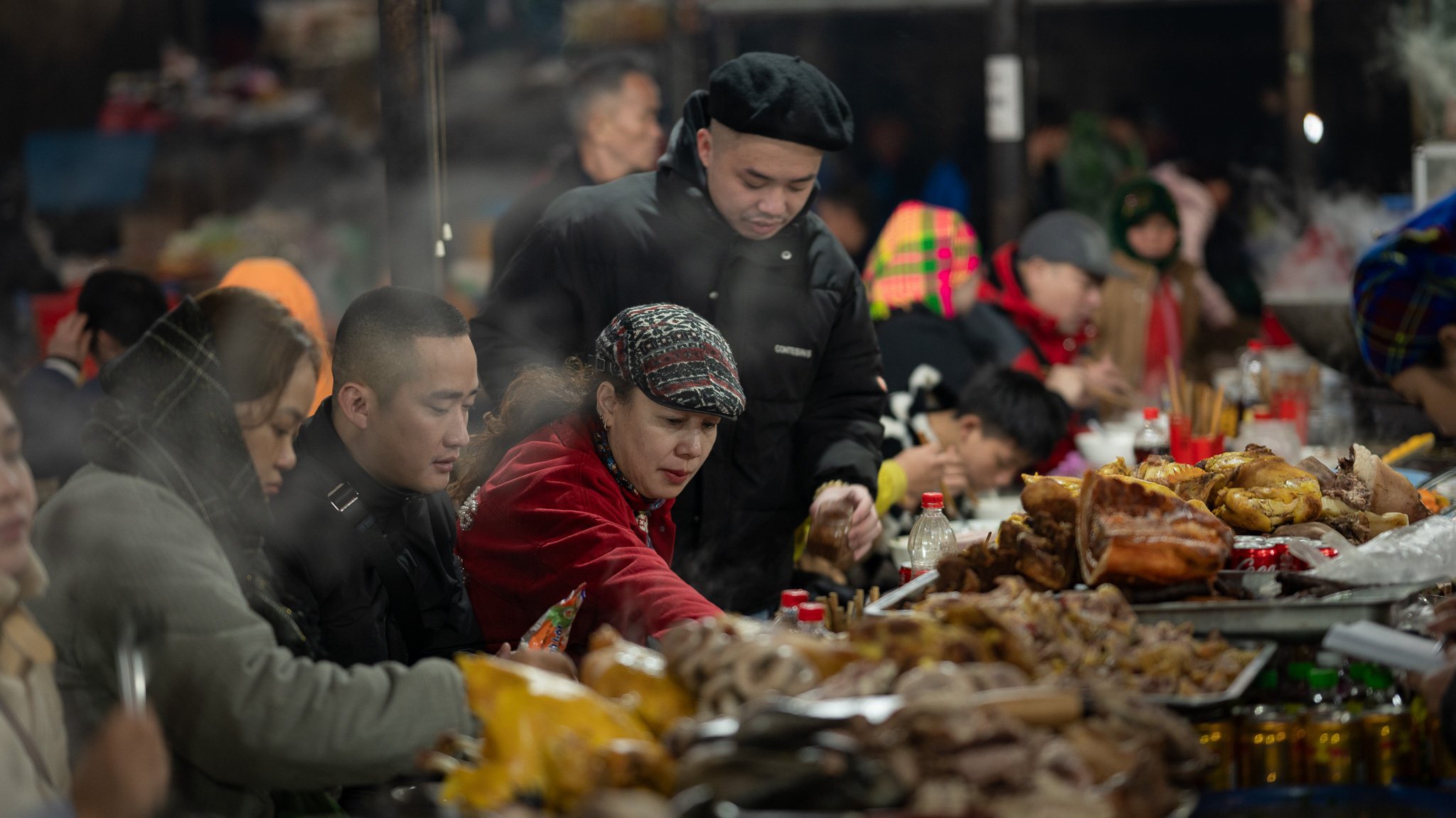
Above is everything you need to know about Ha Giang’s sour pho specialty. While this dish might seem unusual at first, it becomes addictive once you’ve tried it. If you want to enjoy an authentic plate of sour pho in a truly local setting, contact Phieutravel.com right away to schedule your journey to the rocky plateau as soon as possible!
Read more:
- 3 Days 2 Nights Ha Giang Loop tour package from Phieu Travel
- The Ultimate Ha Giang Loop Guide (2025): Itinerary, Map & Tips
- The Ultimate Guide to Ha Giang in March: Flowers, Weather & Tips
- Au Tau Porridge: Ha Giang’s Nighttime Delicacy You Must Try

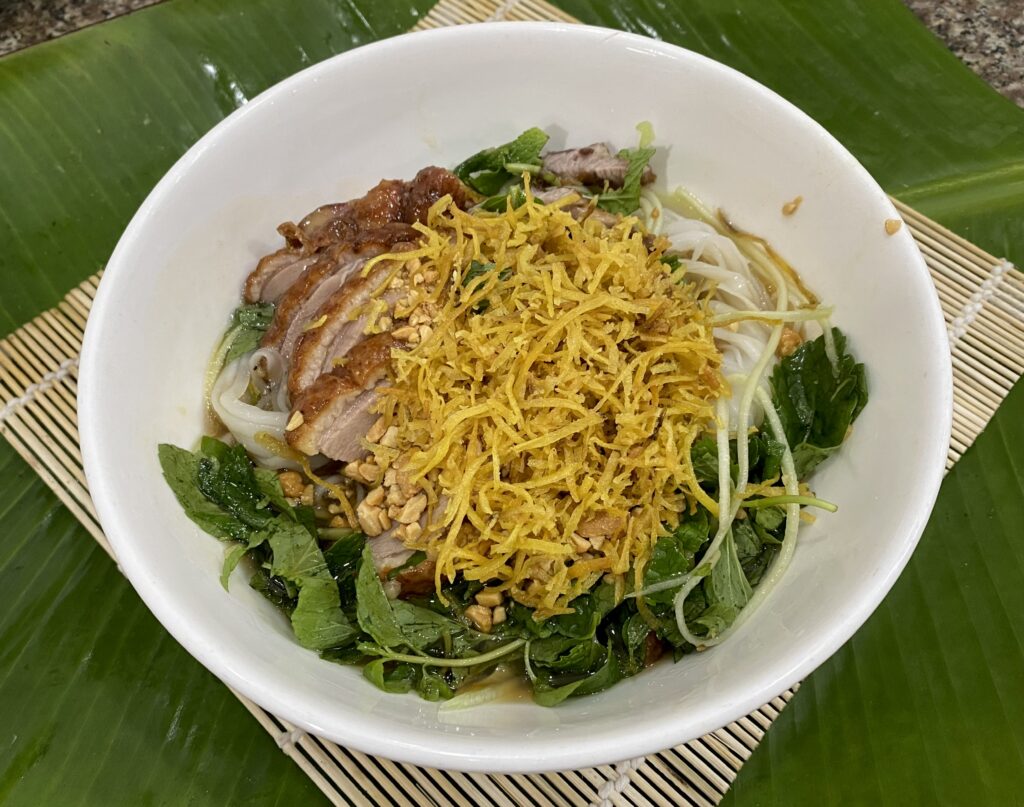
You Might Also Like
Ha Giang Weather in September: Complete Guide for Travelers
Exploring the magnificent Ha Giang Loop in September offers travelers a perfect balance of favorable[...]
Quan Ba Twin Mountains: Ha Giang’s Iconic Fairy Hills and Complete Travel Guide
The mystical Quan Ba Twin Mountains rise from the emerald valleys of Ha Giang like[...]
Vuong family mansion: the architectural marvel and cultural legacy of Ha Giang
Deep in Vietnam’s northern highlands, where mist-shrouded mountains meet terraced rice fields, stands a testament[...]
Ha Giang Loop Safety Tips: How to Ride Securely in Vietnam’s Northern Mountains
The Ha Giang Loop, with its winding mountain roads and breathtaking landscapes, offers one of[...]
The Ultimate Guide to the M-Shaped Curve on Ha Giang Loop
Vietnam’s remote northern province of Ha Giang hides a natural wonder that has captivated adventurous[...]
Most Beautiful Places to Visit in Vietnam: Essential Destinations and Insider Tips
Vietnam captivates travelers with its stunning landscapes, rich cultural heritage, and warm hospitality. From mist-shrouded[...]
Beyond the Beaten Path: Discovering Ha Giang Province in Northeast Vietnam
Ha Giang Province in Northeast Vietnam stands as one of the country’s last frontiers for[...]
Rainy season in Ha Giang: what to expect, when to go, and travel tips
Vietnam’s northern frontier reveals a different face during the rainy season, transforming Ha Giang’s limestone[...]